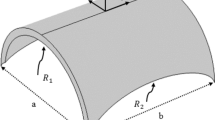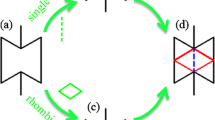Abstract
In this paper, a new type of auxetic honeycomb is designed, which introduces arc walls into the concave hexagonal honeycomb cells and has higher specific energy absorption. The deformation modes and energy absorption of the designed honeycomb are analyzed by using three methods including finite element, compression experiment and machine learning methods. A fully connected two-hidden layer backpropagation deep neural network (BP-DNN) is developed to predict the energy absorptions of the honeycomb with different geometric parameters. It is found that the error of the validation set is low, and the average correlation coefficient of the validation set is 99.2%, which indicates that the neural network can obtain good predictions. The sensitivity analysis of the input parameters shows that the thickness t has the highest sensitivity, and the ratio of the length of the straight wall to the height has the lowest sensitivity to the energy. In addition, the neural network developed can also predict the mechanical properties of the honeycombs outside the parameter range of the training set and the results are consistent with that of the sensitivity analysis. The DNN provides a fast and accurate method for the energy absorption of honeycombs, which is expected to speed up the optimization and design process of honeycomb structures.



















Similar content being viewed by others
Data availability
Data will be available on request.
References
Jiang, Y.L., Shi, K., Zhou, L.N., et al.: 3D-printed auxetic-structured intervertebral disc implant for potential treatment of lumbar herniated disc. Bioact. Mater. 20, 528–538 (2022)
Simpson, J., Kazanc, Z.: Crushing investigation of crash boxes filled with honeycomb and re-entrant (auxetic) lattices. Thin Walled Struct. 150, 106676 (2020)
Krishnan, B.R., Biswas, A.N., Ahalya Kumar, K.V., et al.: Auxetic structure metamaterial for crash safety of sports helmet. Mater. Today. Proc. 56, 1043–1049 (2022)
Bohara, R.P., Linforth, S., Nguyen, T., et al.: Dual-mechanism auxetic-core protective sandwich structure under blast loading. Compos. Struct. 299, 116088 (2022)
Zhong, R., Ren, X., Zhang, X.X., et al.: Mechanical properties of concrete composites with auxetic single and layered honeycomb structures. Constr. Build. Mater. 322, 126453 (2022)
Zhao, M.D., Yuan, H., Du, J.L., et al.: Plastic behavior of foam-filled negative Poisson’s ratio beams. Eng. Struct. 273, 115092 (2022)
Qin, Q.H., Xia, Y.M., Li, J.F., et al.: On dynamic crushing behavior of honeycomb-like hierarchical structures with perforated walls: experimental and numerical investigations. Int. J. Impact Eng 145, 103674 (2020)
Jiang, Y.Y., Li, Y.N.: 3D printed auxetic mechanical metamaterial with chiral cells and re-entrant cores. Sci. Rep. 8, 2397 (2018)
Guo, M.F., Yang, H., Ma, L.: Design and characterization of 3D AuxHex lattice structures. Int. J. Mech. Sci. 181, 105700 (2020)
Hu, L.L., Luo, Z.R., Zhang, Z.Y., et al.: Mechanical property of re-entrant anti-trichiral honeycombs under large deformation. Compos. Part B Eng. 163, 107–120 (2019)
Lu, H., Wang, X., Chen, T.: In-plane dynamics crushing of a combined auxetic honeycomb with negative Poisson’s ratio and enhanced energy absorption. Thin Walled Struct. 160, 107366 (2021)
Jiang, F., Yang, S., Zhang, Y., et al.: Fabrication and crushing response of graded re-entrant circular auxetic honeycomb. Int. J. Mech. Sci. 242, 107999 (2023)
Zhu, Y.L., Luo, Y., Gao, D.F., et al.: In-plane elastic properties of a novel re-entrant auxetic honeycomb with zigzag inclined ligaments. Eng. Struct. 268, 114788 (2022)
Zhang, X.C., Dong, S.J., An, C.C., et al.: Dynamic crushing behaviors of multi-layered gradient honeycombs with different Poisson’s ratios: a finite element simulation. Int. J. Appl. Mech. 14(1), 2150127 (2022)
Zhu, D.F., Wei, Y.C., Shen, X.Y., et al.: A novel elliptical annular re-entrant auxetic honeycomb with enhanced stiffness. Int. J. Mech. Sci. 262, 108732 (2023). https://doi.org/10.1016/j.ijmecsci
Guo, K., Yang, Z., Yu, C.H., et al.: Artificial intelligence and machine learning in design of mechanical materials. Mater. Horiz. 8(4), 1153–1172 (2021)
Le, D.K., Yoon, J.Y.: A hybrid CFD-deep learning methodology for improving the accuracy of pressure drop prediction in cyclone separators. Chem. Eng. Res. Des. 190, 296–311 (2023)
Zhang, H., Wang, Y., Lu, K., et al.: SAP-Net: deep learning to predict sound absorption performance of metaporous materials. Mater. Des. 212, 110156 (2021)
Li, M., Lian, S., Wang, F., et al.: Prediction model of organic molecular absorption energies based on deep learning trained by chaos-enhanced accelerated evolutionary algorithm. Sci. Rep. 9, 1–9 (2019)
Gu, G.X., Chen, C.T., Buehler, M.J.: De novo composite design based on machine learning algorithm. Extreme Mech. Lett. 18, 19–28 (2018)
Wilt, J.K., Yang, C., Gu, G.X.: Accelerating auxetic metamaterial design with deep learning. Adv. Eng. Mater. 22(5), 1901266 (2020)
Kollmann, H.T., Abueidda, D.W., Koric, S., et al.: Deep learning for topology optimization of 2D metamaterials. Mater. Des. 196, 109098 (2020)
Fontes, A., Shadmehri, F.: Data-driven failure prediction of fiber-reinforced polymer composite materials. Eng. Appl. Artif. Intell. 120, 105834 (2023)
Wang, H., Xiao, S.H., Zhang, C.: Novel planar auxetic metamaterial perforated with orthogonally aligned oval-shaped holes and machine learning solutions. Adv. Eng. Mater. 23, 2100102 (2021)
Zhu, L., Zhang, C., Guo, J., et al.: Deep learning for electromagnetically induced transparency (EIT) metasurface optimization design. J. Phys. D Appl. Phys. 55, 315001 (2022)
Zhang, H., Wang, Y., Zhao, H., et al.: Accelerated topological design of metaporous materials of broadband sound absorption performance by generative adversarial networks. Mater. Des. 207, 109855 (2021)
Vyavahare, S., Teraiya, S., Kumar, S.: FDM manufactured auxetic structures: an investigation of mechanical properties using machine learning techniques. Int. J. Solids Struct. 265, 112126 (2023)
Hamzehei, R., Zolfagharian, A., Dariushi, S., et al.: 3D-printed bio-inspired zero Poisson’s ratio graded metamaterials with high energy absorption performance. Smart Mater. Struct. 31, 035001 (2022)
Qi, C., Jiang, F., Remennikov, A., et al.: Quasi-static crushing behavior of novel re-entrant circular auxetic honeycombs. Compos. Part B Eng. 197, 108117 (2020)
Deng, X.L., Qin, S.A.: In-plane energy absorption characteristics and mechanical properties of novel re-entrant honeycombs. Compos. Struct. 313, 116951 (2023)
Zhang, X., Zhang, H., Wen, Z.Z.: Experimental and numerical studies on the crush resistance of aluminum honeycombs with various cell configurations. Int. J. Impact Eng 66, 48–59 (2014)
Haghighat, E., Juanes, R.: SciANN: a Keras/TensorFlow wrapper for scientific computations and physics-informed deep learning using artificial neural networks. Comput. Methods Appl. Mech. Eng. 373, 113552 (2020)
Tan, H.L., He, Z.C., Li, E., et al.: Crashworthiness design and multi-objective optimization of a novel auxetic hierarchical honeycomb crash box. Struct. Multidiscip. Optim. 64, 2009–2024 (2021)
Acknowledgements
The authors gratefully acknowledge the support of National Natural Science Foundation of China No. 12272057.
Funding
This study was supported by National Natural Science Foundation of China No. 12272057.
Author information
Authors and Affiliations
Corresponding author
Ethics declarations
Conflict of interest
The authors have no relevant financial or non-financial interests to disclose.
Additional information
Publisher's Note
Springer Nature remains neutral with regard to jurisdictional claims in published maps and institutional affiliations.
Rights and permissions
Springer Nature or its licensor (e.g. a society or other partner) holds exclusive rights to this article under a publishing agreement with the author(s) or other rightsholder(s); author self-archiving of the accepted manuscript version of this article is solely governed by the terms of such publishing agreement and applicable law.
About this article
Cite this article
Zhang, J., Ma, P. Energy absorption properties of a novel auxetic honeycomb based on deep learning technology. Acta Mech (2024). https://doi.org/10.1007/s00707-024-03960-9
Received:
Revised:
Accepted:
Published:
DOI: https://doi.org/10.1007/s00707-024-03960-9




